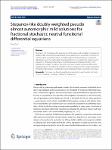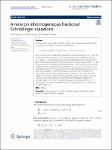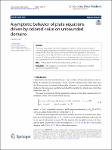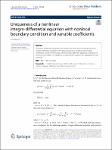Search
Author
- Carlos, Alegría (2)
- Carlos, Seara (2)
- David, Orden (2)
- Klaus, Bretterbauer (2)
- next >
Subject
Date issued
Has File(s)
- true (287)
Search Results
This paper first investigates the equivalence of the space and translation invariance of Stepanov-like doubly weighted pseudo almost automorphic stochastic processes for nonequivalent weight functions; secondly, based on semigroup theory, fractional calculations, and the Krasnoselskii fixed-point theorem, we obtain the existence and uniqueness of Stepanov-like doubly weighted pseudo almost automorphic mild solutions for a class of nonlinear fractional stochastic neutral functional differential equations under non-Lipschitz conditions. These results enrich the complex dynamics of Stepanov-like doubly weighted pseudo almost automorphic stochastic processes. |
This study presents an analysis of two aesthetic properties, complexity and diversity, in Palladian architecture. The former highlights the fractal dimension of façade geometry, and the latter its semantic randomness. Along with a methodological description and advice on settings, this study contributes to the discussion about mathematical beauty in architecture. |
We use the associated ground states and some sharp Gagliardo–Nirenberg inequalities. Moreover, we investigate the L2 concentration of the mass-critical blowing-up solutions. Finally, in the attractive regime, we prove the scattering of energy global solutions. Since there is a loss of regularity in Strichartz estimates for the fractional Schrödinger problem with nonradial data, in this work, we assume that u|t=0 is spherically symmetric. The blowup results use ideas of the pioneering work by Boulenger el al. (J. Funct. Anal. 271:2569–2603, 2016). |
This paper investigates mainly the asymptotic behavior of the nonautonomous random dynamical systems generated by the plate equations driven by colored noise defined on Rn. First, we prove the well-posedness of the equation in the natural energy space. Secondly, we define a continuous cocycle associated with the solution operator. Finally, we establish the existence and uniqueness of random attractors of the equation by the uniform tail-ends estimates methods and the splitting technique. |
We consider a 3d multi-structure composed of two joined perpendicular thin films: a vertical one with small thickness han and a horizontal one with small thickness hbn. We study the asymptotic behavior, as han and hbn
tend to zero, of an eigenvalue problem for the Laplacian defined on this multi-structure. |
We study a general version of the Cheeger inequality by considering the shape functional Fp,q(Ω)=λ1/pp(Ω)/λ1/qq(Ω). The infimum and the supremum of Fp,q are studied in the class of all domains Ω of Rd
and in the subclass of convex domains. In the latter case the issue concerning the existence of an optimal domain for Fp,q is discussed. |
This paper studies the uniqueness of solutions to a two-term nonlinear fractional integro-differential equation with nonlocal boundary condition and variable coefficients based on the Mittag-Leffler function, Babenko’s approach, and Banach’s contractive principle. An example is also provided to illustrate the applications of our theorem. |
Numerical analysts and scientists working in applications often observe that once they improve their techniques to get a better accuracy, some instability of the evaluation creeps in through the back door. This paper shows for a large class of numerical methods that such a Trade-off Principle between error and evaluation stability is unavoidable. It is an instance of a no free lunch theorem. Here, evaluation is the mathematical map that takes input data to output data. This is independent from the numerical routine that calculates the output. Therefore, evaluation stability is different from computational stability. The setting is confined to recovery of functions from data, but it includes solving differential equations by writing such methods as a recovery of functions under const... |
In this paper, we study C1-regularity of minimizers of integral functionals of the Calculus of Variations with widely degenerate convex integrands of the form
F(u):=∫Ω[F(Du)+f⋅u]dx, |
This paper provides a theoretical and numerical investigation of a penalty decomposition scheme for the solution of optimization problems with geometric constraints. In particular, we consider some situations where parts of the constraints are nonconvex and complicated, like cardinality constraints, disjunctive programs, or matrix problems involving rank constraints. By a variable duplication and decomposition strategy, the method presented here explicitly handles these difficult constraints, thus generating iterates which are feasible with respect to them, while the remaining (standard and supposingly simple) constraints are tackled by sequential penalization. Inexact optimization steps are proven sufficient for the resulting algorithm to work, so that it is employable even with di... |










